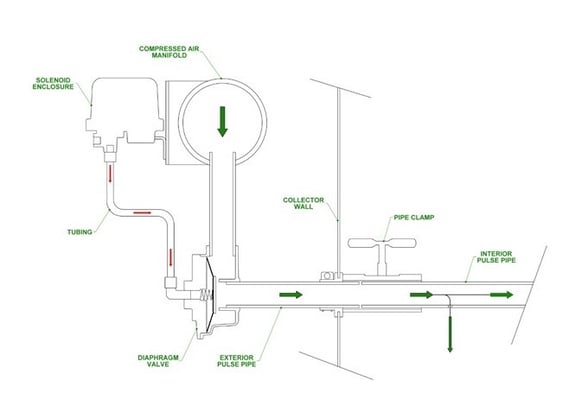If you operate a pulse-jet dust collector system, you need to keep the filter bags clean. This requires a reliable source of compressed air to pulse-clean the bags. But how much compressed air do you need? This will depend on how many bags you are cleaning, their diameter and their length.
To determine how much compressed air is needed, it is helpful to understand how the cleaning process works. Many dust collection systems use a right-angle body diaphragm valve. Air comes in from one direction and flows out at a 90-degree angle. An internal diaphragm controls how much air passes through the valve.
The diaphragm valve consists of an upper and a lower chamber. A flexible diaphragm separates the lower chamber of the valve (which connects to the pulse pipe) from the upper chamber (which connects to a solenoid valve). The solenoid core seals off an exhaust port. When an electrical current is passed through the solenoid’s coil, it creates a magnetic field inside that coil that pulls up the inner metal core. This opens the solenoid valve which allows the air from the upper chamber of the diaphragm valve to escape into the atmosphere. The resultant pressure imbalance inside the diaphragm valve causes the diaphragm to flex, allowing the air coming in from the compressed air manifold to pass through the pulse pipe into the dust collector for cleaning.

How Much Compressed Air Do You Need?
How much compressed air do you need for your system? There are many factors to take into consideration:
- Line Pressure: Plant air supplies vary, and the suggested pulse pressure can be adjusted with the use of a filter-regulator. For most applications, Sly recommends operating at a line pressure of 90-100 psig. If only lower pressure is available, Sly can offer suggestions to change the configuration of the pulse system and dust collector geometry to accommodate the site conditions. Examples are adjusting valve size, frequency of pulsing, number of bags in a row or length of bags.
- Diaphragm Valve Size: Diaphragm valves are available in a variety of sizes. The larger the valve, the more air is consumed in pulse-cleaning. Sly designs each pulse system for the most economical yet effective use of cleaning air. Valve size selection is dependent on the number of bags in each row to be cleaned, the length of the bags, and the available compressed air supply.
- Number of Valves: This is the number of diaphragm valves pulsed at one time. Oftentimes in larger dust collectors, multiple solenoid valves may be connected to a single terminal on the timer. This allows several rows of bags to be pulse cleaned simultaneously, increasing the required scfm of compressed air.
- Size of the Compressed Air Header(s): It is important to consider the size of the air header which acts as a reservoir of readily available compressed With multiple valves pulsing simultaneously, and when larger valves are employed, the compressed air header diameter should be sized to be responsive to the compressed air usage. A pressure transmitter may be used to alarm a condition where an insufficient amount of compressed air is available.
- Electrical On-Time in the Solenoid: How long the solenoid is open determines how much compressed air is used each time a pulse occurs. In general, pulses last from 50-100 milliseconds. It is seldom recommended to adjust this setting from the manufacturer’s setting.
- Interval Time between Pulsing: The pulse timer allows variable settings in the intervals between energizing the solenoid valve for pulse-cleaning. It is recommended to pulse as infrequently as possible to maintain a steady pressure drop in the dust collector. Too frequent pulsing will result in accelerated wear to the filter bags and excess use of compressed air.
- Demand Pulse: A reading of differential pressure can be used to signal when pulse-cleaning is needed, and when it can be discontinued for a period of time to optimize the amount of pulse-cleaning taking place.
The cost of the compressed air supply may be the greatest operating cost in running a pulse-jet dust collector. Proper design and sizing of the compressed air system and its components help to keep your system running at its optimal level while keeping operating costs down. Sly works closely with our customers with custom dust collection solutions. You can rely on our 143+ years of expertise to design the right system for you. Request a quote or call us at 1-866-721-3545 for more information.




